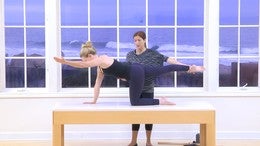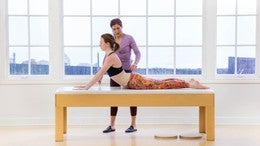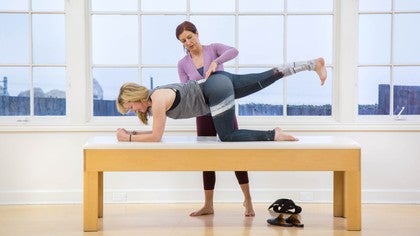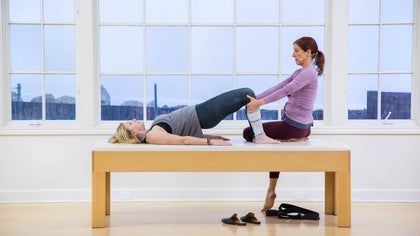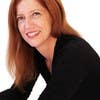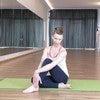Description
Note: Any assessments should be done by a licensed physical therapist as this is not within the scope of practice for a Pilates teacher.
About This Video
Transcript
Read Full Transcript
Hi, I'm Sherry bets and I'm here to talk about stenosis. That usually occurs in people over 50. It usually occurs bilaterally, but not always. And it's usually indicated when someone is having leg pain more than back pain. They get relief and sitting and they have more pain in standing and walking.
So one of the things we try to differentiate between is disc pain versus um, stenosis type pain. And stenosis means that that due to degenerative changes in the disc and some of the ligaments around the spine, the fossette space or that are for aminal opening where the nerve roots come out gets constricted and that can occur bilaterally or unilaterally. And that will be called lateral recess stenosis. And then central canal stenosis is when the ligamentum flavum gets really thick and it, it compresses the space for the spinal canal. So people will often have bilateral low back pain with that. And then when they, when they try to compensate for that, they often end up with a tucked pelvis, flex knees, right.
And then forward head and then they try to walk and they can't really extend their hip because their pelvis is in this tuck and they're in a permanent state of hip flection and they're not allowed to or not able to extend their hip very much. So dealing with that, getting rid of the pain first usually is what I'm concerned with and making sure they don't do things that make them their pain worse. So first I'd like to just have you stand up and I would show you a few things that I'd be looking for and stenosis [inaudible] so if I were to find that someone has stenosis, I would have them put their hands on their hips and then I want you to try to arch your back. Right. And then that would be painful either on one side or both sides and usually radiating down the legs. And then if they did not have osteoporosis, I would have them flex forward. And then keeping the pelvis, keep the knee straight [inaudible] and then keeping the pelvis level and then see that usually feels better to them. So they'll say, oh yeah, that's, I like doing that. That feels good. But the problem is if they have osteoporosis, you know, and as people get older, more and more people are having it, that's an issue for them.
So what I want to do is try to free up that space in that canal as best I can with exercise and with treatment or interventions. Um, all right, so go ahead and uh, lay down on your back. Yeah. And I'm going to still look for this. I'll do a slump test, which I did in the [inaudible] the side, I'm sorry, the um, sacred ILIAC joint tutorial and I would do that testing and then the straight leg raise test I would certainly do. And the straight leg raise test is often positive with a disc problem and it's also problematic with the stenosis. So here I'm taking up the slack in the spinal, um, the sciatic nerve and then trying to wind up that Sadik nerve from the head all the way to the foot and then lift your head. And if they have pain with that, then I'll make a note of that.
And see if they have pain on either side. Same thing on this side, flex and then take the leg across and rotate inward and then without hiking that hip, I don't want to keep everything neutral and then I could pull the foot down to stress the nerve, the peroneal portion of the nerve and this circle per portion of the psychic nerve and see if either of those provoke pain and then bend your knees and now I'm going to have you lift your hips up in the air and she did that quite beautifully. If that was painful, then I'm going to ask you to really think of lengthening your sacrum and press your tailbone across the room like you're an airplane taking off and see if you can keep that sense of length. Stop there and I'm going to have you put that mid thoracic bone back on the mat. Yes, that's it. And then this one until I get the idea of that sacrum sliding away from the lumbar spine, stop there. Great. And then see if that makes a difference in their pain, then I know that I can change it through exercise. All right. Roll down.
Beautiful. All right. Bring your knees and feet together and then sway your knees to the right and then to the left. And if Amy had stenosis on her right side, that would hurt the right, the right side. She would say that there's pain going to the right because that's what closes down the right side. If she noticed that, oh, that feels good on the left, then I would certainly avoid going to the right if that was painful and closing down that facit and then open the space up on the left. I need to hold the ribs down, open up that space on that right side.
And then I'm going to give her a cue to press the rib cage down. Excellent. And then keep that sense of length on that right side. Right now. See if you can press down in that lumbar air. Yes, exactly. Because here's what I usually see. So do the patient or client rib cage jutting up as they rotate to the right?
Yes. So they're actually an extension when they go to the side. Right? And that's gonna trigger pain. And you're gonna Think, oh well it hurts both ways. Well not necessarily because the way they're doing it, they're really jutting the ribs forward and going into extension. So what I would have them do instead of just going into a pelvic tilt to get relief, because that is a usually a short term solution that doesn't have great longterm results cause they already live in a pelvic tilt. To train them completely in a pelvic tilt is just going to facilitate the problem and and give them a short term relief but not long term results.
So, um, holding the rib cage down and rotating away from the side of the pain and then again triggering or facilitating the rib cage to come down. Then the Lumbar to come down and then asking them to rotate from the top to the bottom of the comeback and then peel the right side off from the bottom to the top to go up.
So hear from here, I'm going to have you separate your feet a little bit. And then I want you to see if you can do that same action of your pelvis without moving your knees, like you're just going to piss in the knees back and forth. But I'm not going to sway back and forth. So yes, the pelvic clock is what we call that and then I'm going to help facilitate her by pulling the thigh forward and then not letting her jut the rib cage up is going to be really important with this so that she brings the right a s I s toward the left rib cage and then back down and then left Asi es toward the right rib cage and down so that she's exactly not jutting the the belly up toward the sky. Yeah. Great. Okay. Another exercise that I love doing is the leg circle with usually with the springs to give them some assistance.
But I'm going to do it without the springs for right now, and I have you straighten your leg and then lift this leg up in the air. Now the first thing is to, let's, I want to get on the table so I can help you. I want you to push toward me and then you're going to notice that that brings your pelvis toward me and then, and push into me a little bit as if you're going to lift up. So yeah, you're doing that same action. Now. I'm going to give you a little traction and I want you to put your pelvis back down. Yeah, that's it. And then push toward me and then put your pelvis back down and see if you can feel that sense of length on that right side opening up.
So I had a gentleman that I worked with that had really bad right-sided stenosis and this is the program that we did and, and several, I've had a bunch of people with stenosis, there's a lot in my clinic. And um, we did this kind of work and then we also suggested that he sleep on his left side with a pillow under the left side of his waist that put him in a little bit of left side bending to open up that right side. And that was miraculous for him because he kept waking up with pain in the morning. And so I knew that something he was doing at night was, um, was provoking his pain. So that's it. So if were trying to get that pelvis down too early, I would want to queue rib cage first. Yes. Then lumbar, then pelvis. Exactly. Great job. Great job. And then pushing me away like that and then try to keep pushing me away and take it down. That's it. There you go. It's like that opposition that you're trying to work on. Exactly. All right, now lay on your left side facing the windows.
That's usually what people do. That's not really moving the spine very much. So what I want is to have her move the rib cage and my goal is, or my cue is to try to get the left right shoulder blade, sorry. Right shoulder blade to the mat. So you're going to get that right shoulder blade to the mat. Now what that does is that opens up this, this right lumbar l five s one segment. That's the one that stenotic, they're not stenotic in their whole spine, their only stenotic and usually that one or two segments and they can rotate everywhere else. So that looks good.
And then I can give her some resistance here to pull up into me and that can allow a little bit more rotation. Bring the shoulder forward a little bit. There you go. And then come on. So I want the arm to be in line with the collar bounds so that she's not getting that shoulder into a compromise position. And then you just gonna go back and forth. So reach for the windows, do a little reach and lengthen. Now linkedin your pelvis. Yeah. So you're always trying to get that space to open up here and then lift the arm to the ceiling and then open.
Great. And then again, I'm the doorframe here so that she can't rotate any more than that, letting that that segment open up. Okay. Another way to get a little more opening here is to drop the feet off the table so she can put the feet on a little stool down there to let the pelvis open and then reach this arm overhead and stretch. So that's sometimes a stretch for, for clients to do and excellent. Okay. And then lay back on your back and excellent. Alright, lastly, one of my favorite exercises for mobilizing the nervous system is to take the legs and straighten them out on the table.
So that seemed like you were trying to get out of it a little bit. So I would work you here and then flex it comes on point, it goes away. Right? Flex the tension comes on point. It goes away. And so what you're trying to do is floss that nerve in the pathway. Sometimes when there's irritation in the canal, there's scar tissue and inflammation that develops and that inflammation provokes scar tissue to form and then the nerve doesn't glide freely in and out of the pathway. So eye movement is helpful for bodies.
So we need to keep moving things, but we have to move things in a very careful way. With a nervous system because otherwise you get things really irritated. So if you were to just hold this stretch and not do anything and just hold it, that would really irritate the nerve usually. So you want to glide that nerve in a careful controlled manner. Then as you get better, the next day you do only about 10 repetitions and then the next day you go back and do it again and then see if you're better or worse.
If you've made yourself worse, you back off. If you made yourself better, you continue. Okay. All right. So some of the exercises that I think are so great for people with stenosis are from the thoracic mobility tutorial. Um, if you look at the tutorial, where we do are with Amy and we're doing all the barrels, spine corrector, sitting against the spine corrector, making sure that the back is supported by the spine, cracked doing thoracic mobility. And then I'm gonna have you turn over on your stomach and I want to see that you're able to lift your leg off the table with working on hip extension. Cause I want her to be able to have a neutral pelvis and then hip extension without irritating that segment. So sometimes as soon as I know my, my gentleman that I was referring to, um, as soon as he lifted the right leg up off the table, he had immediate back pain. Okay. So then I had to have him on a pillow at first maybe lifting up his body so that he was in more of a flexed position and then start to work on that.
So the first thing I would do is just have him tuck the toes under and then straight and just one side and then straighten this leg and just start doing that just to see if he can get into hip extension. Right. And then I just saw the glute fire, which is good. The glute firing is super important because it'll pull that pelvis away from the and the sacrum away from the l five cause you want to pull s one away from l five and get more of this action. You want to think of that and this being super helpful for the patient or client with stenosis. So then straighten that leg and lift the toes. Point the toes and lift. Good. And without arching your back. Right. That's it.
So you may not lift very much. And I'm really making sure that she's not going into lumbar extension with that. So anchor that left pelvis a little bit more pubic bone, a little bit more. There you go. That's much better right there. She does want to go into extension in her lumbar with that a little bit. Yes.
Good. There you go. Nice. And very important to get more mobility and hip extension. So Eve's lunge on the reformer is another favorite, um, for having one leg inflection, one leg in extension. And then coming in to all fours. Amy going onto your elbows. Yes. And then that just puts the hip and more of a flex position, which is usually a lot friendlier. Now straighten that right leg out behind you and then see if you can lift the leg without going into lumbar extension.
Go ahead and then back down. Excellent. Last one. Good. So those are some ideas. Now bend the knees and then go back into child's pose, which usually they love so that you can get that lumbar flex position. They want to be in Lumbar fluxion, which gives them relief. But what we want is to be able to get them in a neutral position so that they can be upright on their feet in a neutral pelvis position with comfort. But a lot of times they have to stay in that flex position because they're just uncomfortable there.
But as we teach them to lift the rib cage away from the pelvis and the pelvis away from the rib cage, so come up to standing. Um, when concept I wanted to talk about was, um, the idea that if you tuck your tail under you, you bring your pelvis away from your rib cage. Now the other idea that people don't think about is keeping your pelvis neutral and then thinking of lifting your rib cage away from your pelvis, right? So if you had a sherpa that was walking around like this, you know, how great would that be? So that the, the rib cage is like a bell swinging backward and you're getting the rib cage over the back of the pelvis and lifting it up. So I think that's what [inaudible] does is you know, you find that sense of length and support from within so that you're taking the rib cage off the pelvis and that decreases the load on the lumbar spine. Okay. All right. So remember you are not your MRI or your imaging or your CT scan.
What you see on that image might not be what's your pain? And we want to make sure that we look clinically or physically at what provokes your pain and what relieves it more so than what's on that picture. So it's really more important what they do in the Palati studio and how they're responding to different movements and techniques than it is what happens on that picture on the screen. Because that may not be what's generating the pain. Cause you can see people with lots of degeneration in their spine, no pain, you know, so you're not your diagnosis. Right. All right. So hopefully that helps. I look forward to seeing you at the next tutorial.
The Teacher's Corner: Common Back Problems
Comments
You need to be a subscriber to post a comment.
Please Log In or Create an Account to start your free trial.
